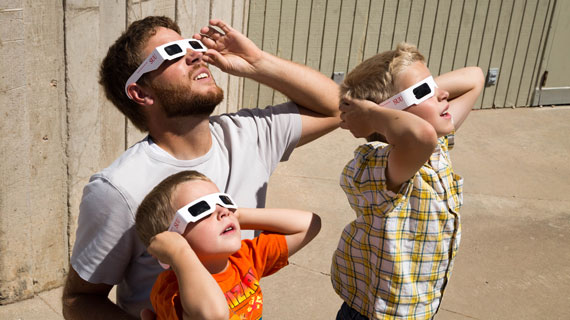The Great American Solar Eclipse of 2017
Published: August 15, 2017 | Author: Miles Anderson | Read Time: 3 minutes
 For the first time in the history of the United States, a total solar eclipse will occur exclusively over the continental U.S. on August 21, 2017. It is also the first total eclipse of the sun visible from the contiguous United States (excluding Alaska and Hawaii) since February 26,1979. The last time a total eclipse was visible from coast to coast was on June 8, 1918.
For the first time in the history of the United States, a total solar eclipse will occur exclusively over the continental U.S. on August 21, 2017. It is also the first total eclipse of the sun visible from the contiguous United States (excluding Alaska and Hawaii) since February 26,1979. The last time a total eclipse was visible from coast to coast was on June 8, 1918.
Celebrating this rare occurrence, Southern Utah University is co-sponsoring a free viewing event at the Main Street Park from 9 a.m. to 1 p.m on August 21. The eclipse will start around 11:20 a.m. but officials recommend viewers come earlier to avoid missing any of the action. Other event sponsors include Cedar City Library in the Park, SUU Ashcroft Observatory, and the Southern Utah Space Foundation. In addition, the SUU Center for STEM Teaching & Learning is distributing 5,000 pairs of solar glasses to local elementary schools in nine southern Utah counties to allow children to safely view the eclipse.
“This eclipse is important because so many people will have the chance to see it,” said Cameron Pace, astronomy professor at Southern Utah University. “It will be a great reminder that what occurs out in space can have a very direct effect here on Earth.”
The Great American Eclipse will darken the skies between Oregon and South Carolina on a path about 70 miles wide. Utahns are not in the direct path of the eclipse, but spectators in southern Utah will still be able to witness an 80 percent eclipse. The nearest location to see a total eclipse is Idaho Falls, Idaho - about a 6-7 hour drive from Cedar City.
Those lucky enough to be in the path of totality are in for an astronomical treat (weather permitting). When the eclipse begins, at first contact, it will appear as if the moon is taking a bite out of the sun. As the eclipse progresses, the sky will get darker, the temperature will drop, and if you pay attention, birds and other animals will become quieter.
At second contact, which is when totality begins, Baily’s Beads become visible. This is the term used to describe the small flecks of light that are still visible on the moon’s outer edge due to the rugged lunar topography.
Just before and just after the moon completely covers the sun’s surface, there is a moment when the light around the moon looks like a diamond ring. Viewers might also see pink spots called prominences near the diamond. These spots are caused by gases on the sun’s surface.
The most exciting thing about a total eclipse, however, is the chance to see the solar corona. The corona is the outermost layer of the sun’s atmosphere and is made up of highly ionized gas. These gases extend millions of kilometers into space and appear as a white gossamer curtain emanating from the sun. Only during a total solar eclipse can the corona be seen with the naked eye. Totality will last roughly 2-3 minutes depending on your location.
For those interested in attending SUU’s Solar Eclipse Party on August 21, there will be a solar telescope, games, treats and solar glasses that will be handed out on a first come, first serve basis.
“If you want to see the eclipse be sure to view it safely,” said Pace. “Get a free pair of solar glasses from our event, order glasses online or look through our solar telescope at the eclipse viewing party.”
Don’t miss the opportunity to view one of the world’s most incredible natural wonders and what is projected to be the most viewed solar eclipse in history.
Contact Information:
435-586-5400
Contact the Office of Marketing Communication
This article was published more than 5 years ago and might contain outdated information or broken links. As a result, its accuracy cannot be guaranteed.
